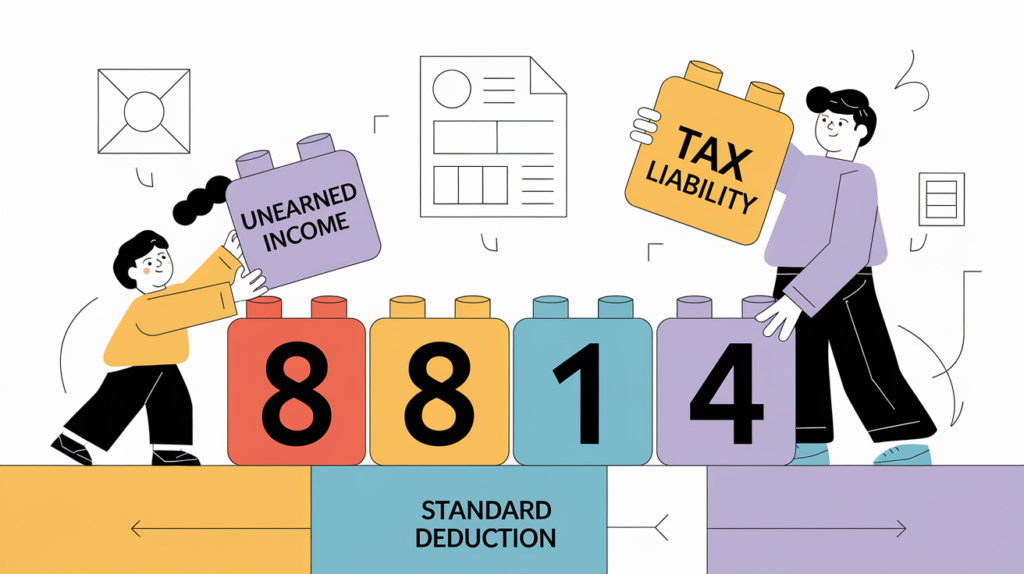Picture this: Your kids are exploring their passions. One is building intricate Lego creations, another is crafting colorful artwork, and your eldest is dabbling in the stock market with a small portfolio. Amid their youthful adventures, they might be earning some income, and that could mean it’s time to talk taxes. That’s where Form 8814 comes into play.
Key Points to Remember
- Simplifying Taxes with Form 8814: Parents can report a child’s investment income on their own tax return using Form 8814, which can make the filing process easier under certain conditions.
- Understanding the Kiddie Tax Threshold: For 2024, if your child has more than $2,650 in unearned income, the Kiddie Tax rules apply and may affect your tax bill.
What Exactly Is Form 8814?
Form 8814, known as the “Parents’ Election to Report Child’s Interest and Dividends,” allows you to include your child’s unearned income on your tax return. Unearned income refers to money not earned from wages or self-employment—it includes interest from savings accounts, dividends from stocks, and capital gain distributions from mutual funds.
By choosing to use Form 8814, you can report your child’s income directly on your return, which might simplify things come tax time. However, this option can sometimes lead to a higher tax bill, so it’s important to weigh the pros and cons.
A Closer Look at Unearned Income
- Interest Income: From savings accounts, certificates of deposit (CDs), or bonds.
- Dividends: Payments from stocks or mutual funds.
- Capital Gain Distributions: Profits distributed from mutual funds or other investments.
Keep in mind that Form 8814 only covers specific types of unearned income. If your child has earned income from a job or other types of unearned income like taxable scholarships, you may need to file a separate tax return for them.
Decoding the Kiddie Tax
The Kiddie Tax is a set of IRS rules designed to prevent parents from shifting investment income to their children to take advantage of lower tax brackets. Essentially, it ensures that a child’s unearned income over a certain amount is taxed at the parent’s tax rate.
When Does the Kiddie Tax Apply?
For the 2024 tax year, the Kiddie Tax comes into play if:
- Your child has more than $2,650 in unearned income.
- They have at least one living parent.
- They are under age 19 at the end of the year, or under age 24 if they are a full-time student.
- They do not file a joint tax return.
- Their earned income does not exceed half of their own support.
Understanding “Support” in Kiddie Tax Rules
“Support” refers to the total cost of providing for your child during the year. This includes expenses for food, shelter, clothing, education, medical care, and recreation. To determine if your child’s earned income exceeds half of their support, compare their earned income to the total amount spent on these necessities.
Understanding whether your child falls under these rules is crucial. If they do, the portion of their unearned income above the threshold will be taxed at your (the parent’s) higher tax rate.
Should You Include Your Child’s Income on Your Return?
Deciding whether to use Form 8814 involves considering several factors.
Potential Increase in Tax Liability
Including your child’s unearned income on your return might push you into a higher tax bracket or increase your taxable income, leading to a larger tax bill.
Impact on Deductions and Credits
A higher adjusted gross income (AGI) due to your child’s income can affect eligibility for certain tax deductions and credits, such as:
- Child Tax Credit
- Education Credits
- Deduction for IRA Contributions
- Medical Expense Deductions
Simplicity and Convenience
On the flip side, reporting your child’s income on your return can make the filing process simpler by avoiding the need to file a separate tax return for your child.
Filing a Separate Tax Return for Your Child
In some situations, it might make more sense to file a separate tax return for your child. This option could be beneficial if:
- Your child has significant unearned income.
- They have earned income from a job.
- They have deductions or credits they can claim on their own return.
- You want to avoid increasing your AGI.
By filing separately, your child will be responsible for their own taxes, and their unearned income will be taxed according to the Kiddie Tax rules.
When to Use Form 8615
If your child needs to file their own return due to significant unearned income, you’ll likely need to use Form 8615, “Tax for Certain Children Who Have Unearned Income.” This form is used when a child’s unearned income exceeds the Kiddie Tax threshold and cannot be included on the parent’s return using Form 8814. Form 8615 helps calculate the tax owed on the child’s unearned income at the parent’s tax rate.
How to Use Form 8814
If you decide that including your child’s income on your return is the best choice, here’s how to proceed.
Step 1: Gather Necessary Information
Collect all relevant tax documents for your child, such as:
- Form 1099-INT for interest income.
- Form 1099-DIV for dividend income.
- Form 1099-B for capital gain distributions (only if they are reported directly as capital gain distributions and not from the sale of securities).
Step 2: Complete Form 8814
Fill out Form 8814 by providing:
- Your child’s name and Social Security number.
- The amount of their interest and dividend income.
- Any federal income tax withheld from their income.
Step 3: Calculate the Tax
On Form 8814, you’ll calculate the tax owed on your child’s income:
- The first $1,250 is generally tax-free, as it is the standard deduction for dependents in 2024.
- The next $1,250 is taxed at the child’s tax rate, which is typically 10% for 2024.
- Any amount over $2,500 is taxed at your (the parent’s) tax rate.
Step 4: Attach Form 8814 to Your Tax Return
Include the completed Form 8814 when you file your Form 1040. Make sure all the numbers are accurately transferred and keep copies of all documents for your records.
Example Scenario
Let’s consider an example to illustrate how this works:
- Child’s Interest Income: $3,000
- Standard Deduction for Dependents (2024): $1,250
- Amount Taxed at Child’s Rate (10%): $1,250
- Amount Taxed at Parent’s Rate: $500 ($3,000 – $1,250 – $1,250)
In this case:
- The first $1,250 is not taxed due to the standard deduction.
- The next $1,250 is taxed at the child’s rate of 10%.
- The remaining $500 is taxed at the parent’s rate.
By using Form 8814, you include these amounts on your tax return, which might simplify the process but could increase your tax liability.
Planning Ahead: Strategies to Manage the Kiddie Tax
If your child is earning unearned income, consider these strategies to minimize the tax impact.
Invest in Tax-Advantaged Accounts
Encourage investments in tax-deferred or tax-free accounts, such as:
- 529 College Savings Plans: Earnings grow tax-free when used for qualified education expenses.
- Coverdell Education Savings Accounts: Similar to 529 plans but with additional investment options.
Utilize Tax-Efficient Investments
Choose investments that generate minimal taxable income, such as:
- Municipal Bonds: Interest is often tax-exempt.
- Growth Stocks or Mutual Funds: Focus on capital appreciation rather than income.
Timing of Income
If possible, manage the timing of income to keep unearned income below the Kiddie Tax threshold. For example, consider deferring income to the following tax year.
Important Considerations
- Changes in Tax Law: Tax laws can change annually. Always check the latest IRS guidelines or consult a tax professional.
- State Taxes: Don’t forget to consider state tax implications, which may have different rules regarding children’s income.
- Financial Aid Impact: A child’s income and assets can affect eligibility for financial aid. Planning is essential if college is on the horizon.
Final Thoughts
Navigating the Kiddie Tax and deciding whether to use Form 8814 can be complex. Understanding how these rules apply to your family’s situation is key to making the best decision.
While including your child’s unearned income on your tax return might make filing simpler, it’s essential to consider the potential impact on your taxes and financial goals. Speaking with a tax professional can provide personalized guidance tailored to your circumstances.
By staying informed and proactive, you can manage your family’s tax obligations effectively, allowing your children to continue exploring their interests while you handle the details behind the scenes.
Need Help with Form 8814 or Kiddie Tax?
For personalized assistance with tax planning and ensuring you’re making the best decisions for your family’s financial well-being, consider reaching out to the professionals at XOA TAX.
- Website: https://www.xoatax.com/
- Phone: +1 (714) 594-6986
- Email: [email protected]
- Contact Page: https://www.xoatax.com/contact-us/
Let XOA TAX help you navigate the complexities of tax laws so you can focus on what matters most—your family.




 anywhere
anywhere  anytime
anytime